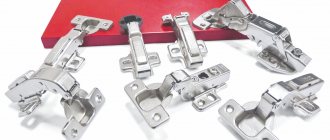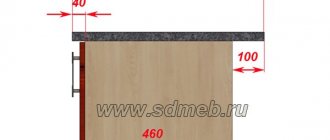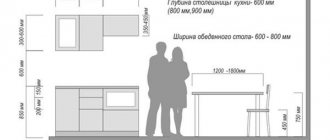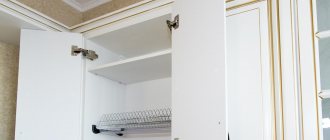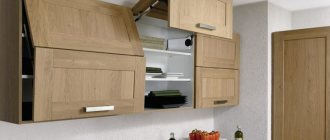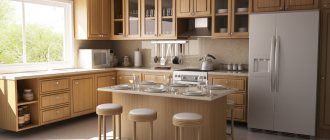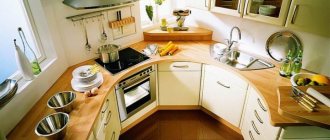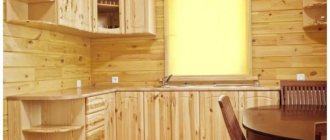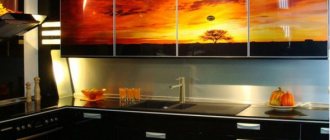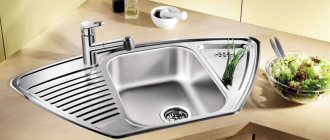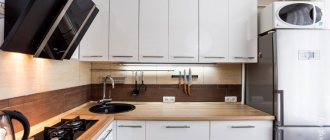The harmony of the space allocated for cooking largely depends on what kind of kitchen set you choose. In particular, the influence will be exerted not only by its appearance, the quality of the material from which the body is made, or the strength of the fittings, but also simply by the dimensions of kitchen cabinets, the standard of which not only exists, but is recommended for use even in the most unusual from an architectural point of view kitchens Let's see what sizes we are talking about.
Kitchen cabinet sizes, standard
What you need to know to size kitchen cabinets
To calculate the appropriate dimensions for kitchen cabinets, it is necessary to take into account some features regarding this process. If you have not had to do this before, of course, you may encounter various difficulties.
For everything to work out, you need to do the work sequentially, namely:
- First, calculate the area of the room by taking general measurements;
- then study the size of the specific part of the kitchen where you will presumably install the set.
The size of the cabinets will be determined, first of all, by the requirements for them.
It is highly advisable during preparation to create a project for the future kitchen, while implementing it, for maximum accuracy, in some 3D editor. Since in this way it is possible to achieve an understanding of the spatial arrangement of cabinets as accurately as possible.
You can develop a drawing on a computer using one of the many design programs. A special article will tell you about the main nuances of making kitchen furniture drawings yourself.
Of course, in order to carry out this embodiment, you will have to hire professionals or ask people with specialized skills to help you. However, if you also have the skills you are looking for, then you will not need outside help.
It is important that in the end the kitchen looks as harmonious as possible
Parameters of cabinets installed in the bottom row
When installing cabinets in the kitchen in the bottom row, it is necessary to clarify the parameters of the room. At the same time, the design style of the kitchen set can also play an important role, provided that the cabinets are equipped with non-standard decorative elements.
Dimensions to consider when developing a kitchen drawing
However, there are standard values that we have devoted this article to, and we now need to study them.
Table 1. Standard parameters of cabinets installed in the bottom row
| Parameter | Meaning |
| Total cabinet height | As a rule, the total height of downward-mounted cabinets is at least 85 centimeters. This height is enough to create enough space inside the furniture to store various dishes and other kitchen utensils. |
| Base height | The height of the plinth, or in other words, the height of the cabinets installed in the bottom row of the kitchen, from the flooring should usually be 10 centimeters. |
| Cabinet depth | The depth of the cabinets in our kitchen set, or rather its bottom row, has a standard value equal to 46 centimeters. So, if, for example, drawers are installed inside this cabinet, then:
|
| Tabletop width | The width of the tabletop, which is installed on cabinets and serves as our working surface, has three standardized sizes:
|
| Table top thickness | The thickness of the installed countertop can also be represented by several standard indicators, namely:
This parameter will directly affect the strength and cost of your kitchen furniture. Accordingly, the thicker, the stronger. |
| Tabletop overhang level | Indeed, you will have to evaluate such an indicator, even if you had not previously suspected it. So, the level of overhang of the tabletop can be:
If you take into account the availability of this reserve, you can safely place behind the cabinets such engineering and network elements as: |
| Front width | The width of the facades is another indicator that has several standard sizes. They will be as follows:
Since furniture is now quite often made to order, as a rule, the width of the cabinets, and with them the fronts, really varies. Please note: you should not install furniture with a facade width of more than 90 centimeters, since such a wide cabinet will cause serious inconvenience when using the piece of furniture. |
| Height of spaces between internal shelves of cabinets | This parameter is usually:
Everything will depend on what purpose this or that locker has. These parameters, although they are standard, are not at all mandatory, you should also take this into account. |
All parameters listed in the table above are closely related to each other. Moreover, on the basis of each of them others are built, therefore, it is important to strictly take into account the dimensions, since only this can help you maintain and increase the maximum functionality and convenience of the space allocated for cooking.
Even if you order furniture with dimensions that are unsuitable for your kitchen, you can “replay” this situation on your own. For example:
- replace too low twist-out legs with parts of greater height;
- basically remove the legs;
- replace a cabinet that is too wide with a narrower one, etc.
Some parameters of the furniture you purchase can be adjusted, for example, you can unscrew the legs and screw in longer or shorter parts.
Of course, in most cases, to make the above changes, you need to pay additional money on top of what you initially spent, so it’s better still make the correct calculations immediately. Then the kitchen will still look as organic as possible.
The most suitable standard tabletop sizes
As for the most suitable standardized sizes, for example, countertops measuring at least 60 centimeters are considered the most popular. The fact is that making the work surface smaller is simply not profitable, since you will need space to cook. In addition, if you install a tabletop of the required size, you can easily subsequently select built-in appliances, for example:
- oven;
- dishwasher;
- hob, etc.
The countertop is the element of the kitchen set that requires special attention.
In general, ideally the countertop should be 90 centimeters in size , but this value is, of course, only suitable for large kitchen spaces. Although, there are also kitchens with countertops whose size is neither more nor less than 120 centimeters, however, we are, of course, talking about professional kitchens, or for those made in the loft style. Using such a large surface, you can even create an island in the middle of the eating or cooking area.
Parameters of top-mounted cabinets
Wall kitchen cabinets also have their own standardized parameters. Knowing them, you can easily decide at what height to install the upper segment of the headset. Of course, calculations, as in the case of cabinets for the lower part of the kitchen, must be carried out in advance so as not to decide in the process which cabinet will go in which part of the room. Let's take a look at what standard features of external cabinets we need to know about.
Like the cabinets in the lower segment of the kitchen, the upper elements of the set have their own standardized sizes
Table 2. What are the standard sizes of kitchen wall cabinets?
| Parameter | Characteristics |
| Upper cabinet height | So, this parameter in the average value will be:
|
| Depth of wall cabinets | The standard depth for overhead cabinets is approximately 30 centimeters. Please note: if the kitchen had a large working surface, the depth of the cabinets should be no less than half of it. |
| Distance from apron to headset | The average distance of this gap is 45 centimeters. Of course, this indicator can vary in such a way as to suit the growth rates of the people using it. So, quite often it is increased to 55 and even 60 centimeters. |
| Front width | The average width of the facades of wall cabinets should coincide with the same value for the cabinets of the lower row. They will be as follows:
|
| Distance to wall-hung kitchen appliances | So, the standard distance, for example, from cabinets to the hood, should be about 70-75 centimeters if it is suspended above an electric stove, and 75-80 centimeters if it is suspended above a gas stove. |
| Permissible height of wall cabinets from the floor to the top end of the cabinet | So, this parameter on average will be about 210 centimeters. However, if you have installed a particularly tall cabinet in your home, then this parameter for it can be 2 meters 50 centimeters. |
Standard size of wall cabinets installed in the kitchen as furniture elements
Kitchen sets with the dimensions indicated in the tables we present are intended for use in the kitchen conditions of typical new buildings that are being built en masse today. It is important to remember that it is necessary to take into account not only the size of floor-mounted or hanging cabinets, but also the distance between these two types of cabinets.
If you don’t know what to put and where, how to place a set with everything you need in a small kitchen, we advise you to carefully study the special article and then apply the knowledge gained from it in practice.
The easiest way to plan a kitchen is to first calculate everything on the drawings
Tabletop placement
Any scheme for creating the optimal placement of a set in the kitchen includes some features of installing the countertop. In the future, it is used as a working part, on which the housewife cuts, butchers and prepares food. For convenient use of ordinary kitchens, the following standard is applied:
- if the owners are short, it is more convenient to place the tabletop at a height of 75 cm from the floor;
- for average people up to 180 cm, installation at a level of 90 cm from the floor is suitable;
- The location of the sink is additionally taken into account; the values must be equal;
- the highest working part for slicing food will provide convenience and eliminate stiffness of movement;
- with a built-in hob, you need to make it slightly lower than the main countertop;
- the optimal depth is 70 cm, the distance will prevent hitting your head on wall cabinets.
It is very important to decide on the material for the countertop. The most popular is chipboard with an additional coating that protects against moisture. You can also apply a laminated film, which will extend its service life.
Standard parameters of corner cabinets
In a room such as a kitchen, kitchen units are often installed, which occupy not one, but two walls of the room, even if each one is not from beginning to end. Thus, you have to play up the corner itself, installing there the most spacious of cabinets - corner ones.
Corner element
Like other types of cabinets, this element of the kitchen set also has its own standard sizes. Let's look at them further in the table.
Table 3. Standard sizes of corner cabinets
| Parameter | Magnitude |
| Height | The floor-to-ceiling height of this cabinet must be standardized in order for the kitchen space to function as efficiently as possible. In this case we are talking about the level of cabinets:
|
| Depth | As we remember, depth is another important parameter. You need to define it for cabinets located both in the upper part of the set and in the lower part:
|
| Front width | This parameter is also very standardized, as, in fact, for all types of kitchens. It will be from 30 to 40 centimeters. |
| Table top thickness | The thickness of the countertop on the corner parts of the kitchen will be exactly the same as on other cabinets. Of course, as in all other cases, it is most appropriate to choose products characterized by the greatest possible thickness, especially when it comes to embedding a sink into it. |
| Distance from work surface | This parameter should not be less than 46 centimeters. |
Almost all kitchens installed today are corner ones.
As in the case of ordinary cabinets, you have the opportunity to select the size of a corner kitchen, guided not only by the parameters of the room, but also by your own desires. The most important thing is that you feel comfortable.
How to select the correct size of cabinets
The standard size of kitchen cabinets is therefore a standard because it was designed for use in standard kitchens. However, unfortunately, the premises in our new buildings are not built according to the standard at all; accordingly, even being called standard, they may have slightly different parameters. It turns out that cabinets need to be selected based on this risk. But it’s better not to take risks, but simply prepare by taking preliminary measurements of the kitchen.
The parameters of the kitchen set, even average ones, may not be suitable for your seemingly typical kitchen
So, the headset should fit into the room as accurately as possible. If, for example, a kitchen water heater is installed, then the pencil case for it needs to be built in so that it:
- did not clutter the room;
- fit in height.
Of course, if the furniture is selected for a kitchen that is decorated in a loft style, then, most likely, you don’t have to worry so much, since a loft does not imply the presence of small rooms at all. However, for all other kitchens, choosing furniture products is not so easy.
Loft style kitchen
Height detection
So, the optimal height of cabinets from the floor should be from 180 to 250 centimeters. At the same time, the height of the cabinets located below should be selected based on the height of the people using it. So, on average it will be about 85 centimeters. Therefore, when choosing a specific cabinet, try to immediately evaluate the dimensions of the products. They must necessarily match your height.
Ergonomics in the kitchen
The same should be done for the upper cabinets. Imagine that you hung them too high, while your height, so to speak, is small. As a result, it will be very inconvenient for you to get dishes and other kitchen kitsch from the upper, and sometimes lower, shelves.
Between the tabletop of the lower row of cabinets, as well as the lower end parts of the upper row, there should not be a distance exceeding a gap of 45 or 50 centimeters.
If you don’t guess with some sizes, then you yourself will subsequently find it inconvenient to cook in your own kitchen and, in principle, to be there
The total height of kitchen cabinets from floor to ceiling should not exceed 250 centimeters , since in this case the pieces of furniture we are interested in simply will not be included in either a standard or non-standard kitchen, with the only possible exception when it comes to on the design of space in a separate residential building.
Depth detection
Such an indicator as the depth of the cabinets is very important, since it is this that ensures the complete and most comfortable storage of the items you need in the kitchen, for example, sets of dishes and other utensils. Thus, it is recommended to increase the standard value of 20-40 centimeters, for example, to 50.
Today it is quite easy to make custom furniture, so you can move away from standardized norms in favor of less trivial solutions
However, if you want, you can also design cabinets of greater depth, the only thing is that in this case you need to make sure that they do not clutter the room.
Definition of width
Standard widths for kitchen cabinets may vary due to certain differences between these designs.
Table 4. Width of cabinets of various designs
| Description of design | Options |
| Single door lockers | This indicator of a single-leaf type of structure, the width normally ranges from 30 to 50 centimeters |
| Double door cabinets | For cabinets with two doors, the figure we are interested in will be approximately 60 to 100 centimeters |
| Corner designs | Corner cabinets, as a rule, are produced by themselves with a width of 90 centimeters. At the same time, however, the width of their facades is calculated according to the formula of isosceles triangles, which we have known since the time we studied geometry at school. So, in our case it will be equal to 130 centimeters. |
| Upper cabinet width | The width of the upper cabinets directly depends on the same indicator for the lower cabinets. So on average this figure ranges from 30 to 100 centimeters. |
| Facades of upper corner structures | An indicator such as the width calculated for the upper corner cabinets will be about 85 centimeters. |
Kitchen ergonomic rules
Headset layout
Kitchen furniture is selected based on the layout of the room. Almost any product is suitable for square or rectangular objects, so there are no problems with the choice.
If the dimensions are non-standard, there are beveled corners, niches and other features, then you need to make furniture to order. Drawings are created by experienced craftsmen who come home to take measurements and calculations.
Much of the individual kitchen layout depends on the location of communications and overall dimensions. Based on this, every square meter is made as functional as possible. After agreeing on the plan with the owner, furniture production begins. Among the main standard types of layout there are 4 kitchen options.
Direct
A universal and cheapest option, suitable for a standard layout. It is possible to achieve a compact but comfortable workplace. The set is placed in a row against the longest wall, the furniture has no corners or turns.
If the length of the entire working part turns out to be more than 3.5 m, then it is better to rearrange the refrigerator and some other equipment or make a design based on the triangle principle. Otherwise, you will have to move around the kitchen a lot while preparing food, which reduces efficiency.
The main advantage is the low cost, because there is no need for individual design. To purchase, you need to know the height and length of the wall. The best option would be a high set with 3 tiers. The solution will visually increase the size of the room, and there will be additional space for storing dishes.
Corner
Corner kitchens are in great demand; they are suitable for installation in any area. For example, they are suitable for Khrushchev-era apartment buildings and large studio kitchens. As a standard, the set is designed in the form of the letter “L”, which provides maximum comfort for the housewife and visually combines the hob with other appliances.
The distance between the refrigerator, stove and other objects should not be more than 1.5 m. When developing a project, the depth of the corner and the configuration of the set are taken into account. Beveled corners look beautiful and unusual. A straight cut is the best option, but the depth should not be very large.
U-shaped
A good solution for a square room. The furniture is located on 3 walls, a tabletop is installed perpendicular to one of them. It acts as a working part and a bar counter. The design is common in a studio kitchen, when two rooms are combined and it is necessary to create zoning of the space.
Island
The option involves the introduction of a module that stands separately from the walls in the center of the kitchen. A hob and sink are installed in it; the dimensions of the modules from the floor are 85–90 cm, but the standard can change at the request of the owner.
Working triangle rule
Even cabinets of the most standardized sizes can be equipped in such a way that your kitchen becomes the most convenient and functional.
Of course, the cabinets themselves are not designed to store any specific items; here the approximate requirements or preferences are very conditional. So, we are talking about:
- storing large dishes, such as pots, in wide cabinets;
- storing cutlery and kitchen textiles, such as towels, in drawers;
- installation in a corner cabinet at the bottom of the trash can.
How the rule of the working triangle works in forges of different locations
However, today they not only put objects in cabinets, but also install built-in equipment that serves us as an assistant in cooking, washing dishes, etc. You also need to learn how to arrange it correctly so that the equipped kitchen is as ergonomic as possible.
Thus, an equipped kitchen should begin with the formation of a working area - a space in which the owner or mistress of the house will spend the greatest amount of time while cooking. It consists of:
- work surface, that is, an electric or gas hob built into a cabinet, or a stationary stove;
- food storage points or points, that is, refrigerator and freezer;
- cleaning zones - places where the sink and dishwasher are placed.
Don’t forget that attention should also be paid to safety precautions.
From the photos presented in this section, you can see that the distance between each of these zones should be approximately equal to two arm lengths of the owners. The whole point is that:
- food is taken out of the refrigerator and carried to the sink;
- then you process them on the countertop;
- then carry it to the work surface to prepare the food;
- At the end of the process, the products are given time to cool, and then they are returned to the refrigerator.
This area needs to be designed correctly, preferably as close as possible to the cabinet in which spices, oils and other non-perishable ingredients for dishes will be stored.
You can choose the appropriate cabinet sizes individually
Keep in mind that it is also necessary to follow basic safety rules, that is, for example, do not place the sink near electrical appliances.
What does ergonomics say?
Taking into account ergonomic requirements, the main elements of furniture in the kitchen must meet the following parameters:
- With a height of 165 cm, the height of the tabletop should be 850 - 900 mm. If you are taller, then leaning towards such a surface will be uncomfortable. The height is chosen so that it is 15 cm lower than the bend of the elbow.
Ergonomics ensures the safety and comfort of using kitchen furniture - The oven is located 10 cm below the shoulder - this is the optimal height, convenient for checking the readiness of the dish and its safe removal from the oven. It is important to place a work surface next to the oven on which you can place a hot baking sheet.
- The volume of the refrigerating and freezing parts of the refrigerator is chosen in accordance with preferences - one of them may predominate or be of equal importance.
- A large kitchen is equipped with a kitchen island, which can be used as an additional work surface for installing a hob or sink. Its height should correspond to the height of the tabletop of the rest of the furniture.
- The size of the sink is also selected depending on preferences - if you have a dishwasher, the size of the sink can be reduced.
- The height of the hood is selected in accordance with safety measures and taking into account the height of the owner.
